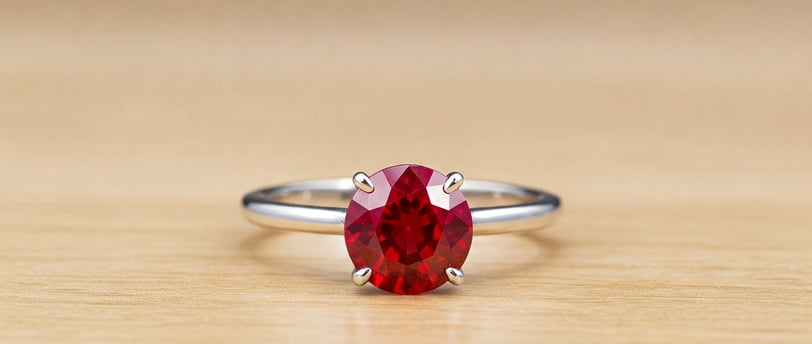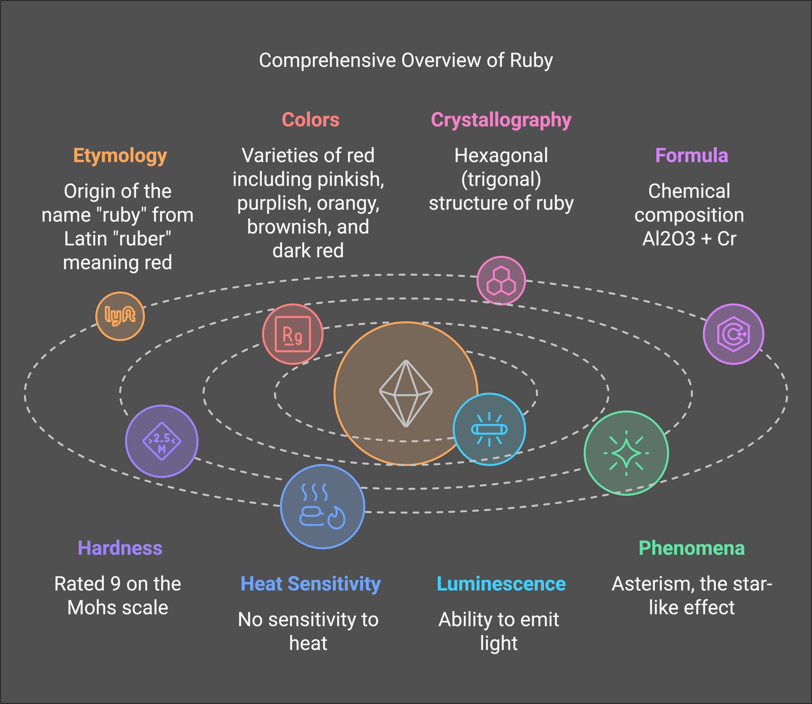Ruby
Explore the world of rubies, the 'king of gems', with their captivating red shades and rich history. This guide will delve into their key features, from their mineral origins to advice on purchasing and caring for these exceptional stones.
1/30/20255 min read


History
The ruby, known in Sanskrit as ratnaraj meaning "king of gems," has been treasured throughout history. It has been associated with fire and blood, representing passion, courage, love, and romance. The Bible celebrates ruby as a precious stone, and many cultures have linked it to wealth and power. Ancient Hindus considered the ruby to be the "King of Gems". Rubies are exceptionally durable. In the past, blood-red gemstones were collectively called "carbuncles," but now gemologists distinguish between different species like garnets, spinels, and rubies. Some historically significant rubies turned out to be other red gems, like spinels. Rubies are one of the most popular traditional jewellery stones. Fine quality rubies can be more valuable than comparably sized diamonds.
Gemstone Mineral Origins
Ruby is a variety of the mineral corundum, which also includes sapphires. The red colour of ruby comes from the trace element chromium. In its purest form, corundum is colourless. Rubies are found worldwide, with variations in colour due to trace minerals. Historically, India was regarded as the origin of rubies for over two thousand years. Myanmar (formerly Burma) is known for producing the highly coveted "pigeon blood red" rubies. Other sources include Sri Lanka, Pakistan, Afghanistan, Thailand, Cambodia, Vietnam, East Africa, and Madagascar. The United States has two small ruby deposits in North Carolina and Montana. Rubies are found in metamorphosed crystalline limestones, dolomites, and igneous rocks such as granite.
The 4 C’s
Colour
Colour is the most significant factor affecting a ruby's value. The finest rubies have a pure, vibrant red to slightly purplish-red colour. Pure red colours typically command the highest prices. The colour should not be too dark or too light. If the colour is too light, the stone might be considered a pink sapphire. Ruby colours can range from pinkish, purplish, orangey, and brownish reds, depending on the chromium and iron content. A top ruby consists of a hue of red, a deep tone, and a vivid saturation, graded as R 6/6. Very good colour rubies range from R 5/6 to stpR 6/6, while good colour rubies range from R 6/5 to stpR 5/6. The colour is described by hue, tone and saturation. The dominant hue is capitalized, other hues are not. The term "pigeon's blood" historically describes the red to slightly purplish or pinkish red colour of rubies with a soft, glowing red fluorescence. Some rubies from Myanmar (Burma) are known for having a "pigeon's blood red" colour.
Clarity
Clarity refers to a gem's transparency and any factors that affect how light transmits through it. Rubies typically contain inclusions. These can be fractures and other materials like liquids, gases, or crystals of other minerals. Inclusions that are very small or not visible to the naked eye are less detrimental to a ruby's value. Top-tier rubies are clarity graded VVS (very very small inclusions) or "loupe clean," meaning no inclusions are visible under 10x magnification. Loupe clean rubies are rare, especially in larger sizes. Second-tier rubies are graded VS (very small inclusions) and are still eye-clean or SI (small inclusions), which may not be eye-clean. Third-tier rubies are graded SI to I (included) and are not eye-clean. Eye-visible inclusions, visible at a distance of approximately 6 inches, can significantly reduce a ruby's price. Inclusions can consist of rutile needles which may create a star effect. If large and prominent inclusions are located under the table facet, they greatly diminish the transparency, brilliance, and value of the stone. Some inclusions, such as rutile silk, can enhance a ruby's appearance by scattering light.
Carat
Gem-quality rubies over 1 carat are very rare, and those over 2 carats are even rarer. The price per carat increases significantly as the size increases. Fine quality rubies over one carat are very rare, but commercial-quality rubies are commonly available in a wide range of sizes. The per-carat prices of fine-quality rubies have been rising consistently, breaking auction records.
Cut
Most rubies are "native cut" in their country of origin. Custom cutting or re-cutting can increase value per carat. Cuts that maximize light return (brilliant cuts) or enhance colour (step cuts) are common for rubies. Cabochon cuts can create a star effect (asterism) with the right arrangement of rutile crystal inclusions. Cabochons are also used for rubies with inclusions that are too unsightly for faceting. The most common shape is a flat tabular hexagonal shape, but ruby crystals from some sources can be elongated. Common ruby cuts are ovals and cushions with brilliant-cut crowns and step-cut pavilions. Other cuts include round, triangular, emerald-cut, pear, and marquise. Cutters try to conserve weight when cutting rubies as the rough material is very expensive which can lead to shallow stones. Pleochroism, where different colours appear in different crystal directions, also influences cut. In ruby, pleochroism typically appears as red to purplish red in one direction and orangy red in another.
Be Aware Of
Enhancements
Rubies are commonly subjected to treatments and enhancements. Most rubies are heat-treated to enhance colour and clarity. Heat treatment is generally accepted in the trade. It dissolves silk inclusions and can improve colour tone and saturation. Other treatments, like diffusion colouring or filling fractures with polymers or leaded glass, can affect the value negatively. The enhancement or treatment of a ruby should be disclosed.
Simulants
Simulated rubies are not rubies at all, and are imitations of glass, plastic, or less-expensive stones that resemble rubies such as garnets and spinels. Some materials combine low-grade ruby with glass.
Synthetics
Synthetic rubies are real rubies, chemically and physically identical to natural rubies. They are created in laboratories and have been around for over a century. Modern techniques make them difficult to distinguish from natural rubies, even for experts. Synthetic rubies are generally marketed with the name of the company and the word "created" rather than "synthetic". The first synthesis was done by the flame fusion method, also known as the Verneuil process.
Final Thoughts
Buying Tips
When buying a ruby, it’s important to work with a trusted jeweller. Look for gemological credentials from a jeweller and ask about treatment information in writing. Do not confuse origin with quality, as even the best mines produce low-quality material. When in doubt, get a lab report from an independent laboratory such as the Gemological Institute of America (GIA) to confirm the ruby is natural and identify any treatments. Be cautious of deals that seem too good to be true. Fine-quality rubies over one carat are very rare. Consider rubies with eye-visible inclusions, as they are more affordable and can still make beautiful jewellery. A masterfully cut stone can attract attention regardless of carat weight. Subtle variations in colour can mean a reduction in price without a significant impact on appearance.
Jewellery Care
Rubies are a durable gemstone, with a hardness of 9 on the Mohs scale. They are suitable for daily wear and are resistant to scratching. Warm, soapy water is always safe for cleaning rubies. Fracture-filled, cavity-filled, or dyed rubies should be cleaned with only a damp cloth. For rubies that are reasonably clear of inclusions or fractures, no special care is necessary and mechanical cleaning is an option. Heavily included or fractured rubies should be cleaned by hand using warm, soapy water and a soft brush. Remove ruby jewellery before bedtime.


Gemius Stones
Expertise
© 2025. All rights reserved.
